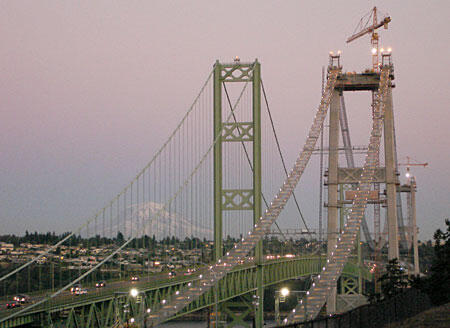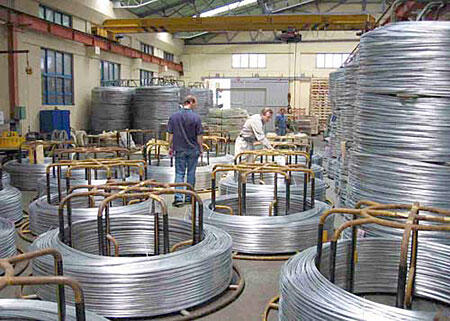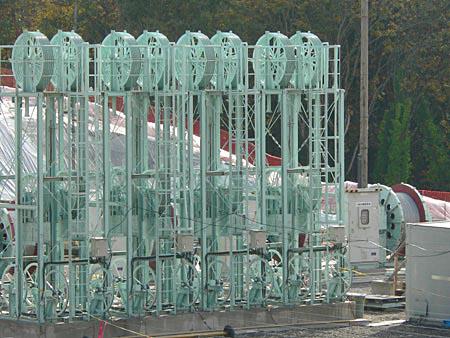Previous posts in the New Narrows Bridge Series:
Spinning Beginning

The engineering beauty of modern suspension bridges lies in the graceful catenary curves of their cables. Starting out as near-gossamer threads of steel wire — no larger than that which you could purchase at your local hardware store — their massive girth and strength support almost unthinkable weight across impossibly wide chasms. Taken for granted as we drive across such majestic spans — perhaps more drawn to the views of water or wilderness they afford–one rarely ponders how such muscular steel sinews are created. It’s a fascinating process–and it’s just begun on the new Narrows Bridge.

Bridges had been suspended from iron chains for nearly 2000 years. But the idea of spinning a wire cable right in place over a river—adding a few strands with each pass—was both new and very radical in the nineteenth century. In 1841, Roebling—a wire cable manufacturer—wrote an article on constructing bridges by building up large cables from many smaller wires, borrowing and enhancing some earlier ideas from European engineers. He first built such a suspension bridge over the Allegheny River, and subsequently completed a series of bridges, including one which spanned the Delaware River between New York and Pennsylvania, part of the Delaware-Hudson canal system. It opened in 1847, 36 years before the Brooklyn Bridge. Roebling also designed and built the more famous Cincinatti Suspension Bridge, which shows many of the design features used in the subsequent Brooklyn Bridge.

The Brooklyn Bridge was an engineering marvel. The tallest structure in New York at the time, half again as long as the longest bridge then constructed, its massive Gothic stone towers were built using an innovative pressurized-air caisson technology to reach bedrock in the East river—over 70 feet down on the New York side.
The depth and high pressure proved dangerous, even deadly, to many workers—including Roebling’s son Washington, who was severely disabled from decompression illness (a.k.a., “the bends”). John Roebling himself died of tetanus from a foot injury during construction, and never lived to see his dream fulfilled. His son Washington directed its completion from his sick bed, using his wife as a courier, mediator, and supervisor to the construction crew and engineers.

Thin steel wires—0.5 cm in diameter in the case of the Narrows bridge—are laid down in pairs by means of a traveling wheel (called a traveler, unsurprisingly, or a sheave). Each pair of wires forms a continuous loop, wrapped about a semicircular grooved shoe (called a strand shoe) at the opposing anchorage, which also serves to adjust their tension.
Repeated strands of wire are looped back and forth across the river, then wrapped into groupings known as strands or tendons. When multiple such tendons had been created, they were again bundled together by wrapping, to form the final cable.
The concept is akin to stacking coins, as each tendon forms a hexagonal shape initially as wires are laid circumferentially in pairs. Wrapping them compresses the individual wires into a more circular shape. The tendons are well-seen in this recent photograph from the Carquinez Straight bridge, recently competed across the Sacramento River near San Francisco:


Steel cable, imported from Japan, arrives in relatively small spools, each containing about 4 miles of wire (seen in the warehouse above, photo courtesy of the News Tribune), are rewound onto larger spools on site onto larger drums, 7-1/2 feet tall, containing about 24 miles of wire. The wire ends are connected with steel ferrules, creating a single continuous wire on each drum.

The preparation area where this occurs is seen above. The drums are then transported to the area just behind the east anchorage, where an elaborate, Rube Goldberg set of pulleys and tensioning wheels is used to guide and control the spooling and feeding of the wires.

The vertical tower helps control the rate of feed and the tension through an elaborate system of pulleys, under active control from a nearby control booth.


I am indebted, however, to two excellent sources for photographs of the Narrows Bridge construction: The Washington State Department of Transportation site, and the Tacoma News Tribune, which has been running a series on the construction. I should be a bit more specific with photo attribution, but life and time are short — so sue me. The WSDOT photos, taken by the construction crews, are typically time and date stamped in red in the lower right. And contrary to rumors, I did not take the photos of the construction of the Brooklyn Bridge—I was a mere boy back then…